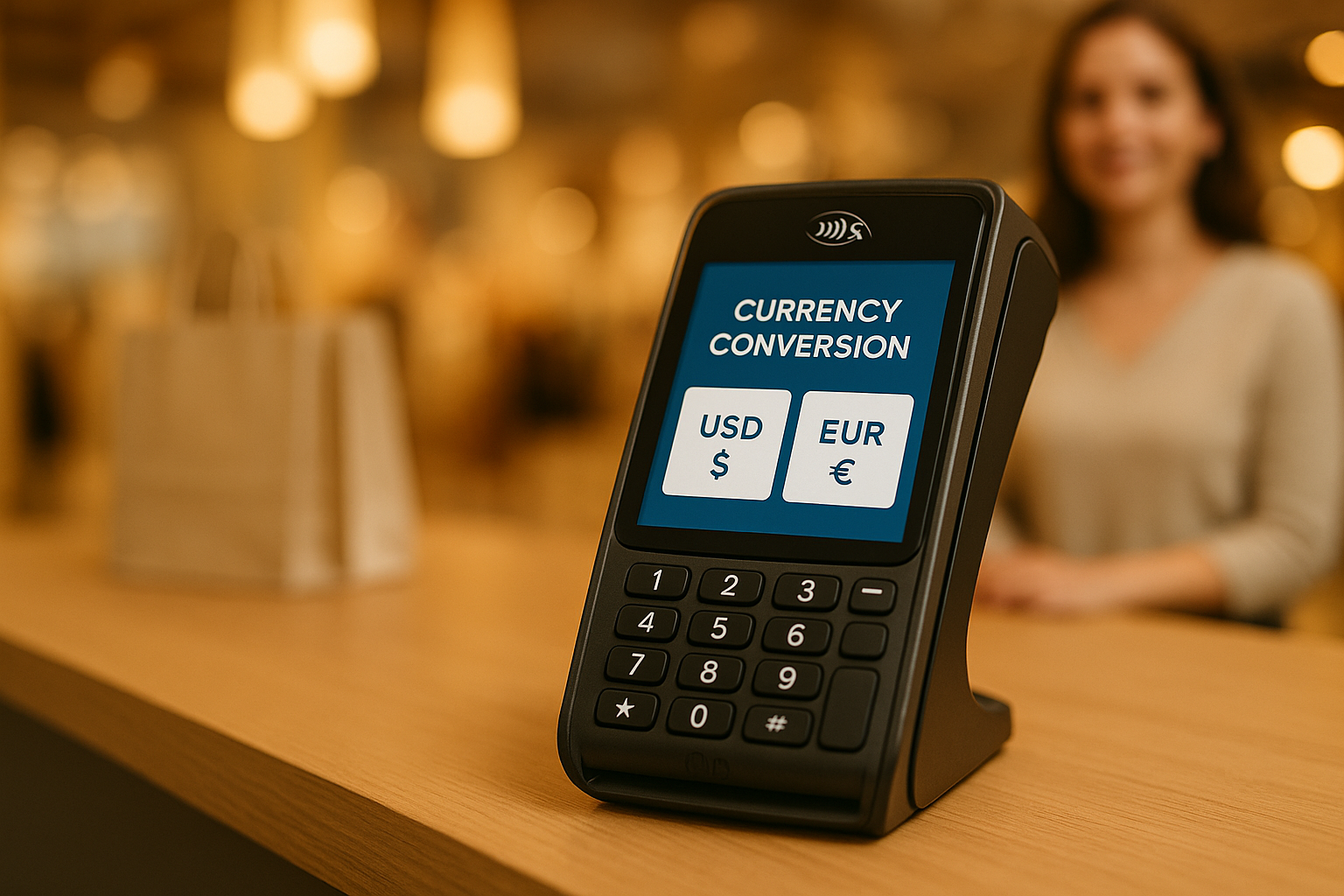Dynamic Currency Conversion (DCC) is a service that lets you pay in your home currency when using a foreign card abroad or online. Here’s how it works and why it matters:
- How It Works: When you use your card, you’re given two options – pay in the local currency or your home currency. The system shows the exact exchange rate, total cost, and any fees upfront.
- Why It’s Useful: DCC provides price transparency, eliminates surprises on your bank statement, and simplifies cross-border payments.
- For Merchants: Businesses can earn extra revenue from conversion fees and enhance the customer experience by offering clear payment options.
- For Customers: You get to see the exact cost in your currency and avoid hidden foreign exchange fees.
Quick Summary of Pros and Cons
| Aspect | Benefits | Drawbacks |
|---|---|---|
| For Customers | Transparent pricing, no hidden fees | Higher costs due to markups (2.6%-18%) |
| For Merchants | Extra revenue, improved customer experience | Compliance challenges, system integration |
DCC simplifies international payments but comes with costs. If offered, weigh the convenience against potential fees before deciding.
How Dynamic Currency Conversion Works
The DCC Process Step by Step
Dynamic Currency Conversion (DCC) unfolds in four key steps, all happening almost instantly at the point of sale. This process simplifies international transactions for both merchants and customers.
Card Detection and Recognition kicks things off. When a customer presents a foreign payment card – whether at a physical point of sale or through an online platform – the system identifies the card’s origin country and home currency (like EUR, AUD, USD, or GBP). This happens during the authorization phase, with the merchant’s DCC provider handling the identification.
Next comes the Currency Option Display. The system gives the customer two choices: pay in the local merchant currency or pay in their own home currency. Both options are shown with the corresponding exchange rate and total cost, providing a clear breakdown of the conversion details.
During Exchange Rate Application and Fee Calculation, the system calculates the conversion rate, which includes a markup that covers the conversion fee and the provider’s margin. This rate is determined by payment processors or card networks like Visa or Mastercard, ensuring compliance with their standards[6].
Finally, it’s time for Customer Choice and Transaction Completion. The customer decides whether to pay in their home currency or stick with the local currency. If they choose the local currency, their home bank handles the conversion. Once the decision is made, the transaction proceeds as usual through the payment network.
This streamlined process makes DCC a practical tool for merchants and payment processors to integrate into their operations.
How Merchants and Payment Processors Handle DCC
Merchants and payment processors play a vital role in making DCC work smoothly, using it to improve both revenue and customer experience. Merchants typically offer DCC through partnerships with specialized providers, creating a system that benefits everyone involved.
Revenue Generation is one of the biggest draws for merchants. When customers opt for DCC, merchants earn from the markup applied to the foreign exchange rate. However, this does mean merchants give up direct control over the exact exchange rate. Still, the process enhances customer satisfaction by offering transparency and choice at checkout.
Payment processors, on the other hand, handle the technical side. They ensure exchange rates meet network standards, manage the infrastructure, and provide the necessary regulatory disclosures to customers.
"DCC empowers merchants to offer international customers a choice in how they pay, along with complete price transparency. Customers know exactly what they’ll pay at checkout, with no hidden fees."
This collaboration between merchants, DCC providers, and payment processors creates a system where everyone benefits. Merchants gain additional revenue and improve customer service, DCC providers earn from the conversion spread, and payment processors ensure smooth international transactions. For businesses like Secured Payments, which specialize in comprehensive payment solutions, DCC can be a valuable addition to their offerings.
To make the most of DCC, Training and Implementation is crucial. Merchants should train their sales teams to understand DCC’s benefits and explain them clearly to customers. This helps staff answer questions and address concerns, ensuring a positive customer experience.
The technical side is relatively simple. DCC requires minimal changes to existing payment systems, as the process of card detection and currency conversion is automated once implemented. This ease of integration makes it an appealing option for businesses looking to enhance their payment systems.
Benefits and Drawbacks of Dynamic Currency Conversion
Benefits for Merchants and Customers
Dynamic Currency Conversion (DCC) offers advantages for both merchants and customers, though the value it brings depends on the perspective. For merchants, DCC provides a fresh revenue opportunity by allowing them to earn a portion of the currency conversion fee when international customers choose to pay in their home currency. This can be particularly appealing as cross-border transactions continue to grow.
Another perk for merchants is the boost in customer satisfaction. By offering DCC, businesses let international customers pay in a currency they’re comfortable with, while still receiving payments in the local currency. This simplifies financial reporting and eliminates the hassle of manual currency conversion. It’s a win-win: customers enjoy a familiar payment experience, and businesses benefit from an additional income stream tied to conversion fees.
For customers, the standout advantage is clarity. DCC ensures they know the exact cost of their purchase in their home currency before completing the transaction. This transparency removes any guesswork and reduces the likelihood of surprise fees later. For merchants, this level of openness can set their service apart, attracting more international clientele. However, DCC isn’t without its challenges.
Potential Drawbacks and Concerns
Despite its benefits, DCC comes with notable downsides for both customers and merchants. For customers, one of the biggest issues is unfavorable exchange rates. Research by the European Consumer Organisation revealed that markups on DCC transactions can range from 2.6% to a staggering 18%. On top of that, additional fees are often tacked on – some reports estimate that about 90% of overseas credit card transactions using DCC include extra charges, which can amount to as much as 5% of the transaction value[8].
Another concern is the inconsistency among DCC providers. Exchange rates and fees vary widely, making it difficult for customers to compare options or predict the final cost[4]. For merchants, there’s the challenge of relinquishing control over foreign exchange rates, as they rely on third-party providers to offer competitive rates. This lack of control, combined with the possibility of customers opting out due to high fees, could negatively impact sales.
Compliance is another hurdle. Merchants must clearly disclose exchange rates and fees, ensuring customers have the choice to accept or decline DCC services. Failing to do so risks alienating customers and damaging trust. Additionally, integrating DCC into existing point-of-sale systems can be expensive and complex. Managing multiple currencies might also complicate internal accounting processes. If customers feel misled due to unclear disclosures, it could harm a business’s reputation.
DCC Pros and Cons Comparison
Here’s a quick overview of the main benefits and drawbacks for merchants and customers:
| Aspect | Benefits | Drawbacks |
|---|---|---|
| For Merchants | Additional revenue from conversion fees; happier customers; easier accounting; competitive edge | Loss of control over exchange rates; compliance demands; costly system integration; potential customer pushback |
| For Customers | Transparent pricing; no hidden fees; familiar currency display; instant cost clarity | Higher costs (2.6%-18% markup); inconsistent provider rates; limited availability; possible automatic opt-in |
| Financial Impact | Merchants earn from conversion fees; potential sales growth | Customers pay 2.6%-12% more on average; extra fees up to 5% of transaction value |
| Operational | Simplifies global transactions; improves customer experience | Regulatory hurdles; staff training needs; integration challenges |
The decision to adopt or use DCC often comes down to balancing these benefits against the potential costs. For merchants, the promise of extra revenue and happier customers may outweigh the implementation challenges. For customers, the convenience of knowing the exact cost in their home currency might come at a higher price they’ll need to weigh carefully.
sbb-itb-8c45743
Best Practices for Implementing Dynamic Currency Conversion
To make Dynamic Currency Conversion (DCC) a beneficial feature for both merchants and customers, it’s important to focus on transparency, employee training, and strict adherence to payment network regulations. Here’s how to implement DCC effectively without compromising customer trust.
Disclose All Fees and Exchange Rates Clearly
Clarity is key when offering DCC. Customers should have all the relevant details about fees and exchange rates before deciding how to pay. Merchants must show:
- The transaction amount in the local currency
- The amount in the customer’s home currency
- The exact exchange rate applied
- Any markup fees included in the conversion.
Payment networks prohibit pre-selecting DCC or presenting it in a way that pressures customers into choosing it. Instead, the option should be displayed neutrally, without suggesting it as the default.
Make sure all rates and fees, including any markup over wholesale exchange rates, are easy to find and understand. A short, straightforward explanation of what DCC entails can also help international customers make informed decisions.
Train Staff on DCC Transactions
Well-trained employees play a crucial role in making DCC work smoothly. Staff should be equipped to explain the service clearly, address customer concerns, and manage the technical steps involved in processing DCC and local currency payments.
Training should include:
- Multilingual instructions on how DCC works
- Clear explanations of fees and exchange rates
- Guidance on answering common questions, like how DCC affects bank statements or what happens if it’s declined
The focus should be on providing accurate information rather than pushing customers toward DCC. Employees should highlight benefits like cost transparency and helping customers avoid unexpected fees, but always let customers make their own choice.
Additionally, staff must understand and follow payment network rules to ensure customers feel confident about their transactions.
Follow Payment Network Compliance Rules
Adhering to payment network rules is non-negotiable – it protects both merchants and their customers. Card networks require that shoppers are given a clear choice to accept or decline DCC and pay in the local currency[10]. Currency conversion must never be forced as a default option.
Merchants must present DCC options in a neutral way, allowing customers to select their preferred currency without bias. Beyond transparency, compliance also includes meeting Payment Card Industry Data Security Standard (PCI DSS) requirements. These standards ensure secure transactions through proper encryption, secure data transmission, and regular security audits.
Failing to comply with these rules can lead to penalties and erode customer trust. Merchants should regularly review DCC transactions for compliance, monitor for unusual rates or system errors, and address customer complaints promptly. Keeping detailed records of all DCC-related interactions and disputes is also essential.
For peace of mind, merchants can collaborate with trusted providers like Secured Payments. Such partnerships ensure that DCC transactions are handled securely, transparently, and in full compliance with industry standards, enabling smooth international transactions for customers.
Conclusion
Dynamic Currency Conversion (DCC) serves as a bridge between merchants and international customers in today’s expanding global marketplace. It offers businesses a way to improve their cross-border payment processes while making transactions more straightforward for customers.
One of DCC’s standout advantages is how it simplifies the billing process. It takes the guesswork out of international transactions by showing customers exactly what they’ll pay in their home currency. This transparency builds trust and encourages customers to complete purchases without worrying about unexpected charges on their bank statements.
DCC also creates an opportunity for businesses to generate additional revenue through conversion fees and markups. For instance, Fiserv clients reported a 30% boost in transaction volume after introducing contactless DCC. Similarly, a prominent European bank experienced a 20% surge in ATM usage within just six months of adopting the service.
Key Takeaways
DCC works best when merchants focus on clarity, proper staff training, and compliance with payment network guidelines. By offering a seamless shopping experience that eliminates financial uncertainty, businesses can increase customer confidence and encourage repeat transactions.
Success with DCC depends on aligning the service with a company’s unique business model and customer needs. Partnering with providers that deliver competitive exchange rates, strong security measures, and reliable compliance ensures smooth implementation. Companies like Secured Payments specialize in helping merchants meet industry standards while maximizing customer satisfaction and revenue potential.
The key to unlocking DCC’s long-term benefits lies in treating it as a value-added service rather than just a profit generator. By focusing on improving the customer experience, businesses can achieve higher conversion rates, better satisfaction scores, and build loyalty among international shoppers. With DCC, merchants not only grow their revenue but also foster trust and confidence on a global scale.
FAQs
What is Dynamic Currency Conversion, and how does it impact the cost of a transaction?
Dynamic Currency Conversion (DCC) gives customers the option to pay in their home currency during international transactions. While it might feel convenient to see the price in a familiar currency, this convenience often comes at a cost – higher fees and less favorable exchange rates – which can increase the total expense by 3% to 5%.
Though DCC offers clarity by displaying the amount in your own currency upfront, the extra fees and markups can make it pricier than standard currency conversion methods. It’s important to carefully check the terms before choosing DCC to avoid paying more than necessary.
What compliance challenges might merchants encounter with Dynamic Currency Conversion?
When implementing Dynamic Currency Conversion (DCC), merchants often encounter compliance hurdles. These typically involve meeting strict regulatory guidelines, being upfront about fees and exchange rates, and providing clear, accurate disclosures to customers. Falling short on any of these fronts can result in fines or legal complications.
Staying current with changing regulations and keeping thorough documentation are critical steps to avoid violations. This is especially true in the United States, where industries with heavy oversight face stricter enforcement. By focusing on compliance, businesses not only minimize risks but also strengthen customer trust.
How can merchants offer a transparent and fair Dynamic Currency Conversion (DCC) experience to customers?
Merchants can provide a fair and transparent Dynamic Currency Conversion (DCC) experience by clearly displaying the real-time exchange rate alongside any additional fees right from the start. This way, customers can make an informed choice about whether to use DCC or stick with their card’s original currency.
Transparency is key. Merchants should avoid automatically selecting DCC for customers or pressuring them into choosing it. Instead, the process should remain entirely optional, with straightforward instructions at checkout. Positioning the payment terminal so customers can easily view and select their preferred currency adds another layer of trust. These practices not only boost customer confidence in cross-border transactions but also align with best practices in the industry.




